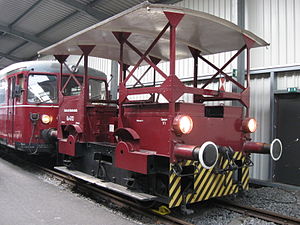AEG A6000-6003
| AEG A6000-6003 | |
|---|---|
|
Ka 4013 in the Bochum-Dahlhausen Railway Museum
|
|
| Numbering: | AEG A6000-6003 DRG Ks 4012-4015 DB Ka 4012-4015 from 1968: 381 101-5 |
| Number: | 4th |
| Manufacturer: | AEG |
| Year of construction (s): | 1930 |
| Retirement: | 1992 |
| Axis formula : | Bo |
| Gauge : | 1435 mm ( standard gauge ) |
| Length over buffers: | 5,600 mm |
| Total wheelbase: | 2,500 mm |
| Service mass: | 11,000 kg |
| Friction mass: | 11,000 kg |
| Wheel set mass : | 5,500 kg |
| Top speed: | 30 km / h |
| Starting tractive effort: | 20.5 kN |
| Capacity: | 360 Ah |
| Driving wheel diameter: | 850 mm |
| Drive battery: | 6 Ma 380 |
| Power transmission: | Battery vehicle |
| Number of traction motors: | 2 |
| Brake: | mech. Spindle brake Resistance brake |
The AEG A6000–6003 are storage locomotives with the wheel arrangement Bo, which were manufactured by AEG in 1930 . After completing various test drives and investigations, they were taken over by the Deutsche Reichsbahn .
The locomotives were available on the Deutsche Bundesbahn until the mid-1970s . Two locomotives have been preserved as memorials.
history
Together with the DR small locomotive performance group II , a storage locomotive for light shunting tasks was built at AEG in 1930 . The four produced copies had the internal designation AEG A6000-6003 at AEG .
The vehicles initially served as comparison vehicles with other small locomotives . The costs of the accumulators, the high ascent for the operating personnel and the limited range due to the accumulators compared to the diesel locomotives were criticized. After the test was completed, they were taken over by the Deutsche Reichsbahn with the designation Ks 4012-4015 and used at small train stations. Compared to the Kö, the locomotives differed in their open construction.
technical description
The storage locomotive had two front structures in which the accumulators were housed and a control station in the middle of the vehicle. A roof supported by eight supports was provided to protect the staff. The locomotive was driven from the side step, the open construction allowed a good view of the route. The last remaining locomotive (Ks 4015) was equipped with a fully enclosed driver's cab in the last years of operation.
The vehicles were powered by a battery made up of accumulators with a total capacity of 360 Ah , and the locomotive's two traction motors were designed in a pawl bearing design . The vehicle control was a simple resistance control and was operated with a drive switch .
commitment
During the Second World War , the vehicles were not dependent on fuel . They were taken over by the Deutsche Bundesbahn after the war . In the designation, only the prefix Ka changed . In 1965 there were still three vehicles left.
Preserved locomotives
- The Ks 4013 and the DB Ka 4013 locomotive was retired in 1967. It was given to the German Society for Railway History and is now in the Bochum Railway Museum .
- The Ka 4015 was given the EDP number 381 101-5 in 1968 and was given a driver's cab that was closed on all sides. In 1973 it was retired in Haltingen . At Interfrigo in Basel Badischer Bahnhof it was used until 1992 under the number IF 330 and then taken over by the Nördlingen Railway Museum .
See also
literature
- Horst J. Obermayer: Paperback German Diesel Locomotives . Francksche Verlagsbuchhandlung, Stuttgart 1979, p. 150-151 .
Web links
- Website via KS 4013 at www.deutsche-kleinloks.de
- Website via KS 4013 at https://heinzalbers.org
- Website via KS 4015 at www.entlang-der-gleise.de
Individual evidence
- ^ Photo of the locomotive on the website of the Noerdlingen Railway Museum
- ↑ Horst J. Obermayer: Paperback German Diesel Locomotives . Francksche Verlagsbuchhandlung, Stuttgart 1979, p. 150-151 .
- ↑ Data sheet about the Ka 4013 at www.deutsche-kleinloks.de
- ^ Report on the Ka 4015 at www.entlang-der-gleise.de
